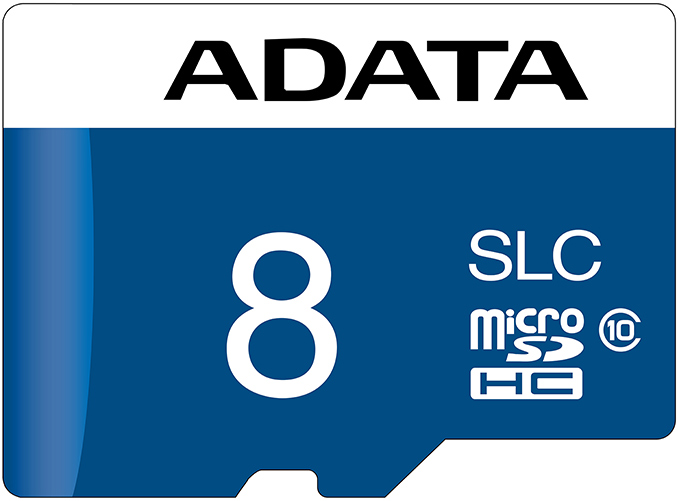ADATA Launches microSD Cards Based on SLC NAND Memory
by Anton Shilov on April 25, 2019 4:00 PM EST- Posted in
- Memory Cards
- ADATA
- SD cards
- SLC

ADATA has introduced a new lineup of microSD cards that use SLC NAND and are aimed at industrial applications. By incorporating the lower-density and higher-reliability memory type, ADATA's IUDD362 are designed to offer enhanced endurance and a longer lifespans than typical TLC/QLC microSD cards, making the cards a better fit for harsh operating conditions.
ADATA’s IUDD362 microSD cards come in capacities of 1 GB, 2 GB, 4 GB, and 8GB. The manufacturer does not disclose the supplier of SLC NAND memory it uses, though the company’s key partners are well known. The devices support read/write speeds of up to 30/25 MB/s, and their power consumption is just 0.6 W.
It goes without saying that these kinds of low performance and capacity figures are not very impressive, especially when more traditional microSD cards can offer many times these figures. But performance isn't the cornerstone of the IUDD362 microSD cards; reliabiltiy is. ADATA says that the controller of the cards fully supports ECC technology, SMART capability that can indicate imminent drive failures, wear leveling, flash protection, hardware power detector, secure erase and other things to ensure maximum stability and reliability. As a result, the cards are rated for a 3 million hours MTBF.
Given the focus on reliability, unsurprisingly ADATA has also hardened the cards to operate in harsh environments. All told, the cards are rated to operate in wide range of temperatures, from -40°C to 85°C, making them a very good fit for including industrial automation and transportation systems (in-vehicle data loggers, etc.).
ADATA plans to start sales of its IUDD362 microSD cards shortly. Parties interested in getting them are advised to contact the company.
Related Reading:
- Kingston Launches High-Endurance microSD Cards: Up to 128 GB
- SanDisk Launches SD and microSD for Industrial and Automotive: Extreme Temps, Upped Reliability
- ADATA Launches ISSS314 and IM2P3388 Industrial SSDs: 3D NAND, Extreme Temps
- Micron and Western Digital Unveil 1 TB microSD Cards with A2
- HiDisc’s 1 TB SDXC Card with A2 Rating Now at Retail
- Lexar at CES 2019: 1 TB SDXC UHD-I Memory Card Announced
Source: ADATA










28 Comments
View All Comments
shabby - Thursday, April 25, 2019 - link
I hope they cost $1, $2, $4 and $8.kamm2 - Thursday, April 25, 2019 - link
On Ebay and Amazon, shipped from China. Probably already there. All genuine of course.DanNeely - Thursday, April 25, 2019 - link
Industrial is priced similarly to Enterprise. $10, 20, 40, 80, if not $100, 200, 400, and 800 is more likely with availability being "call a sales weasel". They're definitely not going to be priced at anything you or I would be willing to pay unless we had some device that was writing regular sd cards to death on a regular basis.eek2121 - Friday, April 26, 2019 - link
That's about all they are worth. I've never had a Micro SD card fail, and I use them quite frequently with my asus tinkerboard-s, raspberry pi 2, and even on my PC as backup. You can get a Samsung Evo 128 gb for $30 for instance. There are also 8 GB cards that cost $8-$9. All are class 10. Kingston even has a 16 gb card for $3.72. To top that off, the Samsung EVO 512 GB card is $139.99 on Amazon.Guspaz - Friday, April 26, 2019 - link
I think your "quite frequent hobby use" doesn't hold a candle to industrial requirements where they want to put this thing in a machine running 24/7 and have it keep working for 40 years. The MTBF rating they've put on it is measured in centuries, not "didn't fail in a raspberry pi".0ldman79 - Friday, April 26, 2019 - link
I've had three different 32GB SD cards die because the media sharing app on my android phone and tablet just kept pushing the card when the phone was idle until it burned it up.Less than six months. I disabled that service and suddenly SD cards last years.
They're not meant for constant use.
These SD cards are. The "bytes written" difference is incredibly huge.
Stan11003 - Wednesday, May 1, 2019 - link
I work with IP Security Cameras. I see them fail all the time. If you write enough video to them they will fail like an SSD if not faster.deil - Thursday, April 25, 2019 - link
only place where it would be useful as I see it is some kind of fist-sized drone, collecting data for a day or so. In this scenario software failure costs you way more than any storage, and its more important that it always return, than high resolution(and masive dataset)rpg1966 - Thursday, April 25, 2019 - link
Yes, they absolutely spent the time and money required to create these with only that specific use-case in mind, having not had any requests from customers that actually need this combination of features.saratoga4 - Friday, April 26, 2019 - link
You're not going to use an SLC SD card in a drone. These are meant in for use in industrial equipment, harsh environments, etc. The use of SLC makes them able to better withstand extreme temperatures without premature aging, whereas a TLC card would need lots of cell refreshes which will wear it out faster.